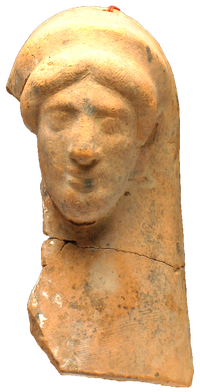Female protome TI-46
Description: The object consists of a long neck and the head adorned with a diadem. Above this is a veil that falls next to the neck, from which it is only vaguely distinguishable. Above the forehead, thick masses of unstreaked hair part slightly at the temples and reach down to about the level of the ears. On the earlobe is a flat jewelled disc (only preserved on the left).
The elongated face with unmoving cheeks and a full chin is dominated by the large nose. Barely bulging eyes are framed by indicated eyelids. Above them, the brows stand out vividly. The lips, curved upwards in the same direction, are not joined at the corners of the mouth.
Commentary: Depicted is a female protome (in literal translation: the one cut off in front), a type that was widespread throughout Hellas, but especially in Ionia. The remarkable depth of the head gives the Giessen example an almost round sculptural effect. Archaic Ionic protomes often have a similar depth of the head, but this is usually combined with a receding profile[2]. Deviations also affect the hair motif. In place of a flat band or closely waved strands of hair[3] indicated before the tiara, an unstructured bulge of hair divided above the forehead has appeared here. In the contour line of the hairstyle and in the long narrow face with a heavy chin, features of the severe style[4] are evident. Archaic forms can only be recognised in the design of the region of the mouth[5].
Comparable stylistic details are found less in Early Classical protomes[6] than in clay statuary of this period, especially in representatives from Attica, Boeotia and the Ionian Islands[7]. As for the reddish-brown clay colour, it resembles that of a young satyr from Pantikapaion[8]. However, whether Protome T I-46 was also made on the northern Black Sea coast and acquired locally by Vogell, or whether it was made in a native Greek workshop, is completely open.
Determination: Around 470 BC; Ionic or Attic.
[1] I owe the information to M. Recke, Giessen.
[2] F. Croissant, Les protomés féminines archaïques (Paris 1983) 39 Typ A3, no. 5 pl. 3 f.; Typ B2a. no. 18 pl. 9 and 12; A. Laumonier, Délos 23 (Paris 1956) 33 fig. 125. 126. 128. 137 pl. 15.
[3] S. Mollard-Besques, Cat. Figurines en terre cuite I (Paris 1954) B 219. 220 pl. 27, ibid. B 215. 216 pl. 27.
[4] V. H. Poulsen, Der strenge Stil (Kopenhagen 1937) 71 fig. 42. 81 fig. 50; R. A. Higgins, Cat. of the Terracottas in the Department of Greek and Roman Antiquities, British Museum (London 1954) 82 f. nos. 206. 212. 213 pl. 36 f. p. 216 f. no. 811 pl. 111.
[5] Ibid 45 f. no. 49 pl. 10, 49 no. 59 pl. 12.
[6] Mollard-Besques ibid. B 218 pl. 27; Lindos 2516. 2519, Chr. Blinkenberg, Lindos. Fouilles et recherches 1902-1914 (Berlin 1931) 604 f. pl. 119; Délos 23, no. 253 pl. 24.
[7] From Attica: Mollard-Besques ibid., 83 C10 pl. 56; U. Sinn, Antike Terrakotten (Kassel 1977) 29 nos. 26. 27 pl. 8. From Boeotia: B. Schmaltz, Terrakotten aus dem Kabirenheiligtum bei Theben (Berlin 1974) 175 nos. 291. 298. 301 pl. 23. From Rhodes: Higgins ibid. 83 f. nos. 210-213 pl. 37. With a different hairstyle and full curved lips, probably created somewhat later, P. Noelke, Kore im Peplos, Antiken aus rheinischem Privatbesitz (Bonn 1972) 178 f. no. 262 pl. 118.
[8] Today Kerch. The figure also comes from the Vogell Collection, see Giessen inv.-no. T I-52.

